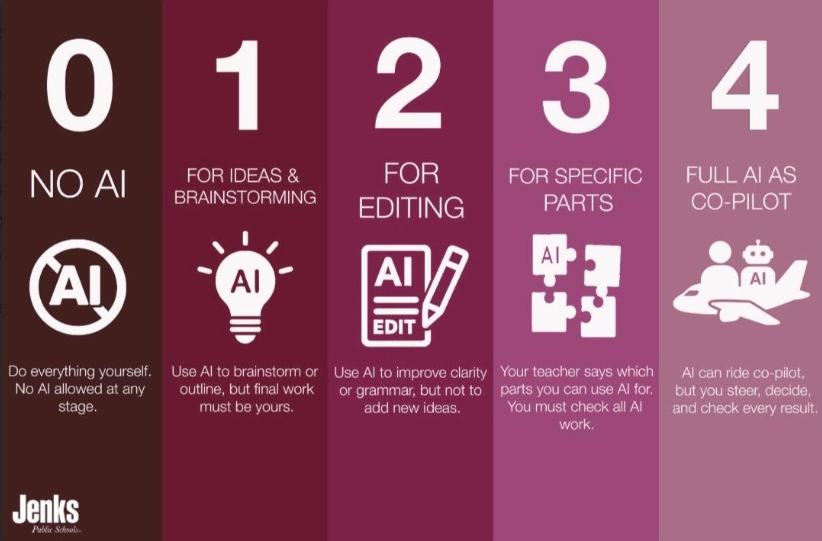To AI or not to AI: Friendly Guide of Ethical and Nonethical Use in School
Photo credits: Jenks Public Schools
By: Lily Miller
Our technological world is ever-presently changing. With the rise of the internet in the early 90s, social media in the early 2000s, and now the emergence of artificial intelligence. We are constantly having to face changes and adapt to those changes, so how do we know what's right and wrong?
AI being publicly introduced into the mainstream media brought on a world of new opportunities. But, as well as fresh opportunities they came with fresh problems. Problems such as improper use (the same as every other technological advancement) but especially within students' schoolwork. It is now very common to see it—even from exemplary students, but from teachers as well. I know personally that I am guilty of AI use, but the question is: how do we use it ethically in our schoolwork?
To say that you haven’t used AI ever would be most likely incorrect -- from teacher or student, it's implemented in almost everything now. It makes our lives immensely easier, but easier doesn’t always mean better. School policy at Jenks high school is if AI has done your assignment, then you will receive a 0, it's viewed as the same as cheating. However, some teachers follow their own procedures. Some teachers give out 50s, and some just have a conversation with you about use (how and why) and then you just re-do the assignment.
Artificial intelligence is so new and so constantly changing that it's hard to try to figure out ways to combat it. The only way we have right now is fighting fire with fire. Detecting AI with AI, and we all know that AI isn’t the most reliable, so it would be reasonable for it not to be reliable against itself.
“I think the biggest and I guess the most incorrect way that [students] misused AI would be to skip the brainstorming, skip the thinking, the critical thinking,” said Sarah Langren, a Sophomore English and poetry teacher Jenks High School. “[They] skip all the processes and simply allow a chat bot to create for them.”
The problem with AI isn’t AI being used itself; that's what it was created for, so we should use it for its intended purpose. No, the problem with AI is how it's being used. When we have it do our work for us, we lose the human touch in our work, and it becomes so robotic, especially because it's not even our work anymore, and it was made by a robot.
“As we’re furiously typing a draft, it's nice for [AI] to tell us, ‘Hey, look at this again,’” said Joy Edwards, an English teacher at Jenks High School. “I like verifying my feedback. I like to see what AI says.”
Some teachers say AI is a great tool because that's what it's meant to be, a tool. The most common problem found among teachers is that it's being used as a crutch rather than a tool. It's easy to just open ChatGPT and copy and paste your whole assignment and have it done for you, but then you’re not honing all the skills that your teachers are trying to teach you.
“I think AI is a great organizational tool,” said Lindsey Taylor, an advanced English 10 and AP seminar teacher at Jenks. “If you’re writing a longer paper, ask AI to help you build an outline.”
While the Jenks High School AI guide is still in its drafting phase, other schools have policies set or at least in the works. Harvard University has set pretty good guidelines for their students, giving steps and suggestions. They also have an approved list for chat bots, what the chat bots are good at, the level of information you are allowed to enter into the bot, and who they are available to for use.
Since AI is so new, most educators don’t have anything fully put together yet to combat it taking over students' assignments. But the common theme among all of the guidelines (finished or unfinished) is that, at most, AI is your co-pilot. It's just there to help you along your way but you steer in the direction you need to be headed.
